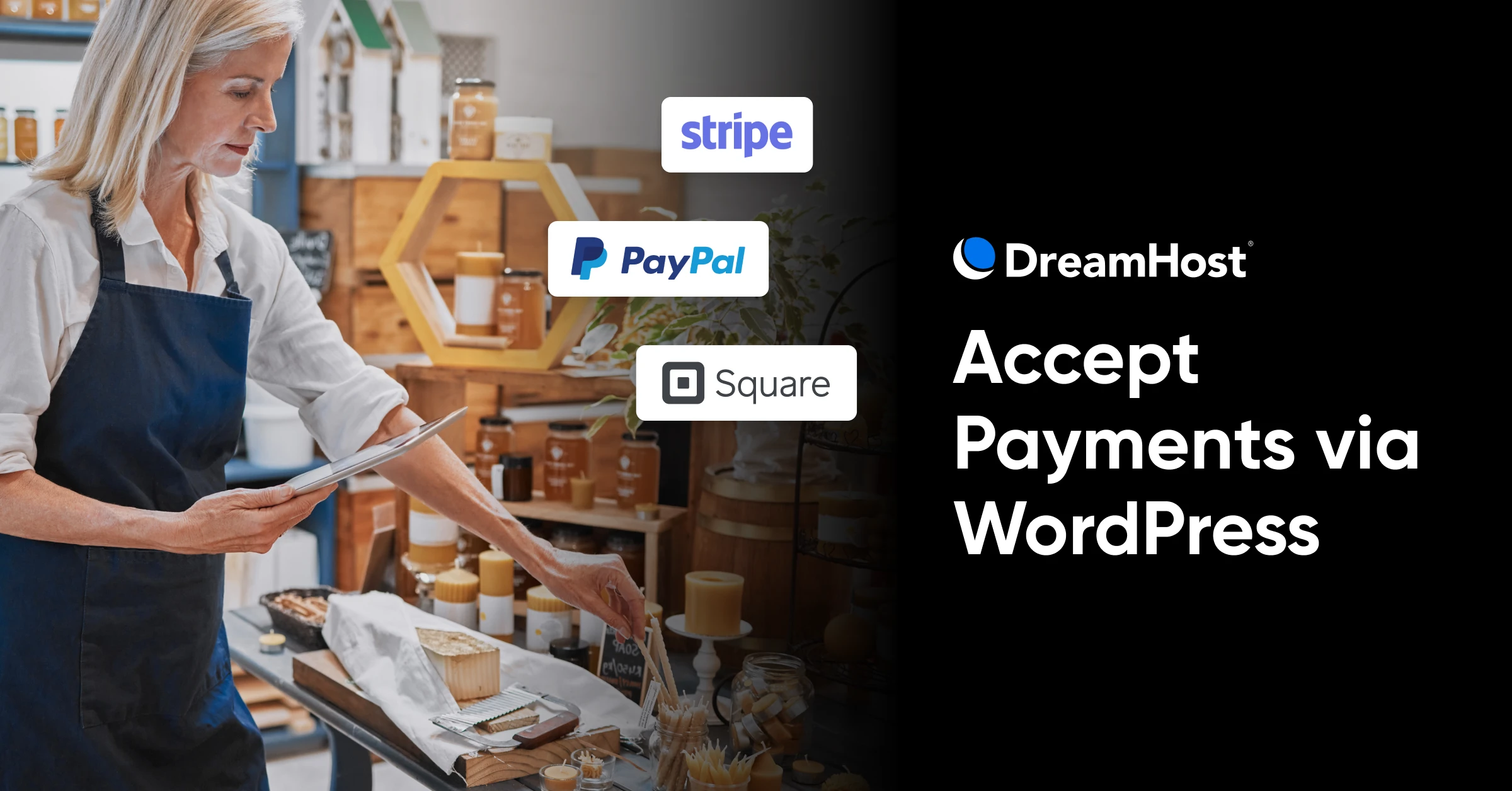How to Accept Payments Through Your WordPress Website

Dreaming of making millions online? First, you’re going to need a payment gateway.
Accepting credit card payments for services or products on your WordPress website is essential if you want to explore new business opportunities. The tricky part is choosing the right option.
Every payment gateway offers something different. Ideally, you want an affordable provider that is fully compatible with your e-commerce store. Understanding what each payment gateway has to offer can help you create the best possible experience for customers.
Ugh, that sounds like a lot of research. To make the process a whole lot easier, we’ve gathered all the key info in one place.
In this article, we’ll cover the basics of online payment platforms. We’ll also review a number of free and premium payment applications that you can add to your WordPress website.
If you’re ready, let’s dive right in!
Why It’s Important to Choose the Right Payment Gateways for Your Website
Payment gateways are services that process credit and debit card payments for merchants.
Your choice of the gateway is important because 70% of online shoppers abandon their carts during the checkout process. Offering your customers a variety of different payment methods is a proven way to keep them happy.
Just as importantly, every gateway has its own pricing model. Your choice of payment processor affects the cut of each sale you will pay in fees.
Technically speaking, a payment gateway can be a standalone software application or physical hardware used in point-of-sale (POS) transactions. In this post, we’re mainly focusing on the software side.
There’s plenty to consider when choosing a gateway for your business, including:
- Payment Card Industry Data Security Standard (PCI DSS): PCI DSS compliance means that a service provider adheres to the information security standard for handling major credit and debit cards.
- Plugin compatibility: Plugins from payment processors vary in terms of features and compatibility. Make sure your chosen gateways are compatible with your site’s theme.
- User experience: It’s worth testing each payment solution to ensure you’re delivering a great user experience during checkout and after.
- Secure Sockets Layer (SSL) Certificates: Any website with online payment options should have an SSL certificate. This ensures that payment data is exchanged via a secure connection.
SSL/TLS
SSL, or Secure Sockets Layer, ensures secure connections to protect data during online transactions and logins. TLS, its successor, enhances security further.
Read More
Bear in mind that most sites offer more than one option. Customers are generally more likely to complete a purchase when they have alternative payment buttons to choose from.
The 6 Best Payment Gateways for WordPress
Now that we know the factors to consider when choosing payment gateways, let’s examine some of the best options for WordPress store owners.
1. Authorize.net: Best Overall Payment Gateway
Owned by Visa, Authorize.net offers free advanced fraud detection services. You can use this gateway to accept payments via credit or debit card, PayPal, and Apple Pay — and it’s pretty easy to set up.
This gateway works with many WordPress plugins, including WooCommerce. On the back end, Authorize.net lets you accept multiple currencies and sync all your transaction data with Quickbooks.
If you also want to take payments in the real world, Authorize.net’s free software lets you turn any Windows-based computer into a POS terminal.
Pros:
- Excellent fraud prevention
- Simple checkout experience
- No contracts
Cons:
Authorize.net fees:
- Account set-up fee: $0
- Monthly gateway fee: $25.00
- Processing fees: $0.10 per transaction + $0.10 daily batch fee
2. PayPal: Best for Convenience
PayPal is probably the most trusted name in payment gateways. That’s a huge plus if you’re starting a new business and trying to win over online shoppers. It might be the easiest option to set up, too.
If you’re only making occasional sales, you can add the PayPal button to any page. This button will link to a checkout hosted on PayPal’s website.
Alternatively, you can set up PayPal as a gateway in your own checkout. It’s compatible with most form and e-commerce plugins.
You can also set up a POS checkout with several hardware options, which include mobile and traditional terminal possibilities.
The only downside of PayPal is that you pay more per transaction than with some other payment processors.
Pros:
- One-tap checkout for PayPal users
- No setup payments
- Easily accept payments in international currencies
Cons:
- Higher fees than some providers
- Not the best customer support
PayPal fees:
- PayPal button fees: 2.99% of transaction + $0.49
- Merchant fees: 3.49% of transaction + $0.49
- POS fees: 2.29% of transaction + $0.09
- Additional 1.5% + fixed fee for international transactions
3. Stripe: Best for International Sales
Stripe is probably your best choice if you do plenty of international business. This gateway accepts over 100 foreign currencies and converts them automatically.
As with PayPal, you can accept payments on your WordPress site via the Stripe payment button or through your own checkout. Either way, Stripe offers good integration with WordPress.
The company has also created its own POS terminal system. You’ll have to purchase this, but it’s a nice option if you plan on doing events or setting up a physical storefront.
Pros:
- Full PCI DSS compliance
- Impressive international payment options
- Great subscription billing
Cons:
- High chargeback fees if customers dispute a purchase
Stripe fees:
- Credit and debit cards: 2.9% + $0.30 per transaction
- Additional 1.5% fee for international cards
- Extra 1% for currency conversion
- Terminal transactions: 2.7% + $0.5 per transaction
4. Amazon Pay: Best for Building Trust
Aside from brand recognition, one of the most significant benefits of using Amazon Pay is that shoppers don’t have to leave your website to complete their payments. Users can log in with their Amazon accounts and complete “in-line” purchases in a familiar and smooth checkout process.
While Amazon Pay does not offer a POS system, you’ll have access to other benefits — including recurring payments, fraud detection, and donation settings.
Pros:
- Trusted brand
- Works in your existing checkout
- Good fraud detection
Cons:
- Fairly high cross-border fees
- Amazon may hold your funds for a period before releasing them
Amazon Pay fees:
- Web and mobile: 2.9% + $0.30 per transaction
- Cross-border transactions: 3.9% + $0.30 per transaction
- Charitable organizations: 2.2% + $0.30 per transaction
5. Square: Best for Startups
Square is a leader in the payment gateway industry. It’s a little more focused on POS than other providers on this list, but online payments work perfectly well. Plus, Square actually has a website builder for online stores.
In terms of POS, we love the virtual terminal. This application enables you to turn any web-connected device into a credit card payment terminal, even without a card swiper.
Pros:
- Integrates with WooCommerce
- Store builder option
- No fees on disputes
Cons:
- Your account might be frozen if you don’t make a sale for some time
Square fees:
- E-commerce: 2.9% + $0.30 per transaction
- Point of sale: 2.6% + $0.10 per transaction
- Monthly subscriptions for additional features starting at $29 per month
6. WooPayments: Best for WooCommerce Integration
Technically speaking, WooPayments is a white-label version of Stripe. The difference is that this solution was specifically made for WooCommerce by the same team that created our favorite e-commerce WordPress plugin.
This means you get tighter integration with WordPress and the ability to manage payments through your store dashboard.
Pros:
- Deep integration with the popular WooCommerce plugin
- All the same advantages as Stripe
Cons:
- Only available via WooCommerce
WooPayments fees:
- Credit and debit cards: 2.90% + $0.30 per transaction
- Additional 1.5% fee for international cards
- Extra 1% for currency conversion
5 Free and Premium Payment Gateway Plugins
As you ponder over these gateways, it’s worth thinking about how well each provider integrates with your WordPress website. Let’s look at a few payment plugins that may help you to simplify that process:
1. Quick Paypal Payments
With Quick Paypal Payments installed, you can add a PayPal button anywhere on your site by pasting a shortcode. It also comes with a block to display the form. It’s not the most sophisticated option, but this plugin is great if you want to start selling immediately.
Key Features:
- Easy to configure
- Plenty of styling options
Price: Free base version, with additional features available for $19.99.
2. WP Full Pay
WP Full Pay is powered (naturally) by Stripe. This plugin makes it easy to add various payment options to your website, including embedded payment forms and recurring payments for subscriptions.
Key Features:
- Lets you create beautiful payment forms
- Allows you to accept donations and recurring payments
- Works for membership sites
Price: The free version charges a 1.9% transaction fee in addition to Stripe fees. The premium version starts at $49 per year and includes unlimited transactions with no additional fees.
3. WP Simple Pay
If you choose Stripe as your payment gateway, WP Simple Pay is another option for integrating payments into your WordPress site. This plugin is pretty much an all-in-one option, which eliminates the need for additional plugins to create a payment experience.
Key Features:
- Displays product images on checkout pages
- Supports over 135 currencies
- Mobile responsive
Price: Lite version is free, while the Pro version starts at $99 per year.
4. Authorize.net Payment Gateway for WooCommerce
Explicitly designed for WooCommerce plugin users, Authorize.net Payment Gateway for WooCommerce offers unique security features for your website. It allows you to take credit card payments in WordPress through Authorize.net, and set rules about specific payment types.
Key Features:
- Secures payments through Authorize.net servers
- Includes optional success and failure messages
Price: This is another free option.
5. WooCommerce
Strictly speaking, WooCommerce isn’t a payment plugin. It’s an entire e-commerce ecosystem for WordPress, allowing you to build and grow your online store.
The key part is that WooCommerce has over 845 available add-ons. These include extensions that connect your store with a wide variety of payment gateways, such as Stripe and PayPal.
Key Features:
- Open-source plugin
- Integrates with over 140 payment gateways
- Includes customizable product, cart, and checkout pages
Price: Free for the base plugin, with payment gateway add-ons ranging from $0–$79 per year.
How to Avoid Mistakes When Adding Payment Options to Your Website
Now that we know the best payment gateways in WordPress, surely it’s all plain sailing from here? Well, yes and no.
While most of these options are fairly easy to set up, it’s still possible to get stuck along the way. Here are a few tips for integrating WordPress payment gateways:
- Invest in good hosting: When choosing a web host, make sure your provider can handle payments online. Check to see if they include SSL/TLS certificates with packages or if you have to purchase one separately.
- Keep things simple: Your site doesn’t need complete shopping cart functionality. You can add just one or two simple payment options if that’s the approach that will work best with your customers and your products or services.
- Test, test, test: Even if everything appears to be configured correctly, test your new payment process. The last thing you want is for your customers to be unable to make a purchase!
Accepting Payments Made Easy
Once you have a solid payment solution in place, you can let your imagination run wild with business ideas!
Here at DreamHost, we want to help you focus on building your online empire. That’s why we offer managed WordPress hosting plans for a variety of needs. We’ll take care of keeping your WordPress installation up to date and running smoothly.

WordPress Hosting
Unbeatable WordPress Hosting
Reliable, lightning-fast hosting solutions specifically optimized for WordPress.
See More


